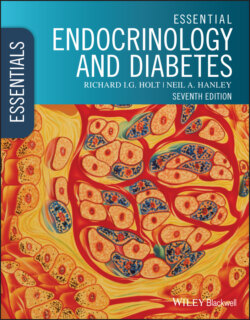Читать книгу Essential Endocrinology and Diabetes - Richard I. G. Holt - Страница 36
Chromosomes, mitosis and meiosis
ОглавлениеGenomic DNA is wrapped around proteins called histones and packaged into chromosomes. The DNA–histone complex is referred to as chromatin. There are 22 pairs of ‘autosomes’ and two sex chromosomes; two Xs in females, one X and a Y in males. This paired composition (‘diploid’) makes females ‘46,XX’ and males ‘46,XY’. 46 refers to the total number of chromosomes. Distinct chromosomes are only apparent when they are lined up in preparation for cell division. Cell division occurs by two processes, either ‘mitosis’ or ‘meiosis’ (Figure 2.1). Mitosis generates two identical daughter cells, each with a full complement of 46 chromosomes, and occurs ∼1017 times during life in humans. In contrast, meiosis creates gametes (i.e. spermatozoan or ovum), each with 23 chromosomes so that full diploid status is reconstituted at fertilization.
Several chromosomal abnormalities can result in endocrine disorders. During meiosis, if a chromosome fails to separate properly from its partner or if migration is delayed, a gamete might result that lacks a chromosome or has too many. Turner syndrome (45,XO) occurs when one sex chromosome is missing while in Klinefelter syndrome (47,XXY) there is an extra one. Similarly, breakages and rejoining across or within chromosomes produce unusual ‘derivative’ chromosomes or ones with duplicated or deleted regions (see Figure 4.4). These events can disrupt gene function, e.g. deletion causing congenital loss of a hormone. Duplication can be equally significant. For instance, on the X chromosome, duplication of a region that includes the dosage‐sensitive sex reversal, adrenal hypoplasia critical region gene 1 (DAX1, also called NR0B1) overrides normal male development in the 46,XY embryonic gonad to result in an ovarian pathway.
